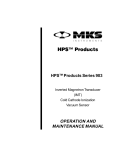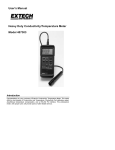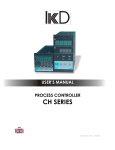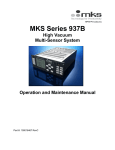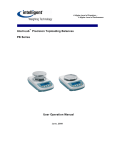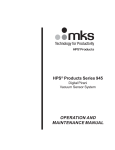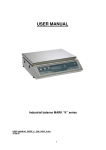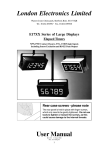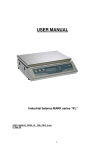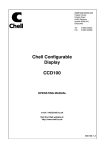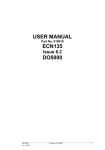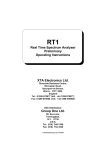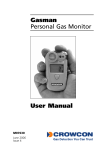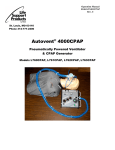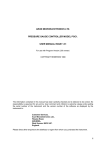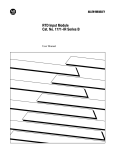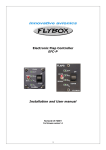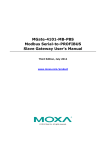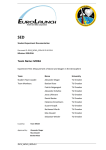Download PDR 9000 Operation and Maintenance Manual
Transcript
PDR 9000 OPERATION AND MAINTENANCE MANUAL Please Note: MKS Instruments provides these documents as the latest version for the revision indicated. The material is subject to change without notice, and should be verified if used in a critical application. PDR 9000 March 1999 PART #100010303 REV. A HPSTM PDR 9000 Part # PDR9000X __ __ Serial # __ __ __ __ __ __ Please fill in these numbers and have them readily available when calling for service or additional information. (The part number can be found on your packing slip, and both the part number and serial number are located on the bottom side of the housing.) For more information or literature, contact: Vacuum Products Group of MKS Instruments, Inc. 5330 Sterling Drive Boulder, CO 80301 USA Phone: FAX: 303-449-9861 800-345-1967 303-442-6880 © 1999 by Vacuum Products Group of MKS Instruments, Inc. All rights reserved. ALCONOX is a registered trademark of Alconox, Inc. IgniTorr is a trademark of MKSTM Instruments of HPSTM, Inc. Inconel is a registered trademark of Inco Alloys International, Inc. Scotch-Brite is a trademark of 3M. SensaVac is a registered trademark of MKS Instruments, Inc. HPSTM PDR 9000 Table of Contents Package Contents ..................................................................... 1 Symbols Used in this Manual .................................................... 1 Safety Precautions .................................................................... 2 Specifications ............................................................................ 4 Feature and Control Locations .................................................. 6 Make Accessory Connection ..................................................... 7 Controls and Indicators ............................................................. 9 Typical Applications for the PDR 9000 .................................... 10 About the HPSTM PDR 9000 .................................................... 11 Installing the PDR 9000 .......................................................... 12 Unpack the Controller .............................................................................. 12 Mount the Controller ................................................................................ 12 Connect the Vacuum Gauge .................................................................... 12 Attach the Cable ..................................................................................... 13 Check Supply Voltage ............................................................................. 13 Attach the Power Cord ............................................................................ 13 Operating the PDR 9000 ......................................................... 14 Turn Power On ........................................................................................ 14 Error Indicators ....................................................................................... 14 Restarting ............................................................................................... 14 Front Panel Controls ................................................................................ 14 CCG Gauge On/Off ................................................................................. 15 Hi Voltage LED ........................................................................................ 15 Autorange ............................................................................................... 15 Set Pt 1 .................................................................................................. 16 Set Pt 2 .................................................................................................. 16 Units ....................................................................................................... 17 Protect .................................................................................................... 17 Reset of Stored Values ........................................................................... 17 Reading Pressure ................................................................................... 18 Analog Output ......................................................................................... 19 Serial Interface ....................................................................................... 20 Using the PDR 9000 with Other Gases ................................... 21 Calibrate ................................................................................................. 21 Maintaining the PDR 9000 ...................................................... 22 Troubleshooting ....................................................................................... 22 Accessories/Part Replacement ............................................... 23 Product Warranty ..................................................................... 24 HPSTM PDR 9000 HPSTM PDR 9000 Package Contents Before unpacking your PDR 9000 Controller, check all surfaces of the packing material for shipping damage. Please be sure your PDR 9000 package includes these items: t Mounting Clips t PDR 9000 Controller unit t D-sub 15 accessory connector t PDR 9000 User manual t PDR 9000 Controller AC power cord Inspect the PDR 9000 for visible damage. If it has been damaged in shipping, notify the carrier immediately. Keep all shipping materials and packaging for claim verification. Do not return the product to HPS Vacuum Gauges The 907 Convection Enhanced Pirani and the 903 Inverted Magnetron transducer may be purchase from MKS Instruments, Inc. Vacuum Products Group 5330 Sterling Dr. Boulder, CO. 80301 USA (303) 449-9861 ( Telephone Toll-Free (800) 345-1967 (USA only) Facsimile (303) 449-2003 Symbols Used in this Manual The first two symbols below, that may be located on your PDR 9000, identify critical safety concerns. They are used throughout this manual to further define the safety concerns associated with the product. The last two symbols identify other information in this manual that is essential or useful in achieving optimal performance from the PDR 9000. CAUTION: Refer to manual. Failure to heed message could result in personal injury or serious damage to the equipment or both. Failure to heed message could result in damage to the equipment. F Calls attention to important procedures, practices, or conditions. HPSTM PDR 9000 1 Safety Precautions Safety Procedures and Precautions The following general safety precautions must be observed during all phases of operation of this instrument. Failure to comply with these precautions or with specific warnings elsewhere in this manual violates safety standards of intended use of the instrument and may impair the protection provided by the equipment. MKS Instruments, Inc. assumes no liability for the customer’s failure to comply with these requirements. Properly ground the Controller. This product is grounded through the grounding conductor of the power cord. To avoid electrical shock, plug the power cord into a properly wired receptacle before connecting it to the product input or output terminals. A protective ground connection by way of the grounding conductor in the power cord is essential for safe operation. Upon loss of the protective-ground connection, all accessible conductive parts (including knobs and controls that may appear to be insulating) can render an electrical shock. Do not substitute parts or modify instrument. Do not install substitute parts or perform any unauthorized modification to the instrument. Return the instrument to an MKS Calibration and Service Center for service and repair to ensure that all safety features are maintained. Use proper electrical fittings. Dangerous voltages are contained within this instrument. All electrical fittings and cables must be of the type specified, and in good condition. All electrical fittings must be properly connected and grounded. Use the proper power source. This product is intended to operate from a power source that applies a voltage between the supply conductors, or between either of the supply conductors and ground, not more than that specified in the manual. 22 HPSTM PDR 9000 Use the proper fuse. Use only a fuse of the correct type, voltage rating, and current rating, as specified for your product. Do not operate in explosive environments. To avoid explosion, do not operate this product in an explosive environment unless it has been specifically certified for such operation. Service by qualified personnel only. Operating personnel must not remove instrument covers. Component replacement and internal adjustments must be made by qualified service personnel only. Use the proper power cord. Use only a power cord that is in good condition and which meets the input power requirements specified in the manual. Use only a detachable cord set with conductors that have a cross-sectional area equal to or greater than 0.75 mm2. The power cable should be approved by a qualified agency such as VDE, Semko, or SEV. HPSTM PDR 9000 3 Specifications Measuring Range 903 3.0 x10-10 to 5.0 x10-3 3.9 x10-10 to 6.4 x 10-3 3.9 x10-8 to 6.5 x 10-1 Torr mBar Pascal 907 1.0 x10-3 to 1.0 x103 1.3 x10-3 to 1.3 x103 1.3 x10-1 to 1.3 x105 Torr mBar Pascal 907 and 903 (dual sensor operation) 3.0 x 10-10 to 1.0 x 103 3.9 x 10-10 to 1.3 x 103 3.9 x 10-8 to 1.3 x 105 Torr mBar Pascal Set Point Range 903 3.0 x 10-10 to 1.0 x 10-3 3.9 x 10-10 to 1.3 x 10-3 3.9 x 10-8 to 1.3 x 10-1 Torr mBar Pascal Set Point Range 907 1.0 x 10-2 to 1.0 x 103 1.5 x 10-2 to 1.3 x 103 1.5 x 10-0 to 1.3 x 105 Torr mBar Pascal Display Range 3x10-10 to 1000 Torr, HI indicates overange LO indicates underange Display Resolution 2 digits with an exponent Input to the PDR 9000 Controller Analog signals from the MKS 907 and/or MKS 903 Units of Display Torr, mBar, Pascal: user selectable Calibration Adjust The appropriate calibration routines are provided depending upon which sensors are plugged in at power up. 44 907 Vacuum and Atmosphere adjustments 903 Sensitivity Adjustment 0.5 - 2.0 HPSTM PDR 9000 Vacuum Gauge The controller can be used to read pressure from a 907, a 903, or both gauges can be plugged in simultaneously. Operating Temperature Range +5 to +40 deg. Celsius Process Control Set Points Two. These relays may be independently assigned to either gauge when used with both the 907 and 903. Alternatively, both relays may be assigned to one gauge. Process Control Relays Two relays; contacts rated at 60 VDC or 30 VAC at 2 amp; the relays are internally fused with 2 amp fuses. Nonvolatile Memory For all user specified parameters Analog Output Logarithmic, 0.5 volts / decade Output Power +15 at 0.35 amp, sufficient to operate the MKS 907 and 903 RS-232 Input/Output Mounting The PDR 9000 may be used as a bench-top instrument or it may be mounted in an instrument panel. Clips are provided for panel mounting. RS-232 Output Allows user to read pressure and set points; 9600 baud, 8-N-1; available through the accessory connector Power Requirement 90 - 265 VAC 47 - 65 HZ Weight 0.9 lb. /0.4 kg Repeatability Approximately +- 5 % Relative Humidity 80% maximum for temperatures less than 31 0 C, decreasing linearly to 50% maximum at 400C Altitude 2000 m (6561 ft) maximum Insulation Pollution Degree 2 CE Certification EMC Directive Safety Directive HPSTM PDR 9000 5 Feature and Control Locations 3 l 4 l 5 l 6 l 1 l 2 l 3 l 4 l 5 l 6 l 7 l 66 CC Gauge On/Off (Setpoint Select) button SELECT button Pirani (Raise) button CCG (Lower) button Digital Display Display Indicators Mode Indicator HPSTM PDR 9000 1 l 7 l 2 l Make Accessory Connection 9 Pin Transducer Connector 15 Pin Accessory Connector Power Connector Fuses The 15-pin D-sub Accessory Connector is on the rear panel of the PDR 9000 , see fig. 2, page 6. The connector has female pins; the mating connector must have male pins. Mating D-sub 15 connectors are available from many of the normal electronic sources. If you need help identifying a source, please contact us The following is the pin assignments for the 15 Pin Accessory Connector: 15-pin Accessory Connector pin 1 pin 2 pin 3 pin 4 pin 5 pin 6 pin 7 pin 8 pin 9 pin 10 pin 11 pin 12 pin 13 pin 14 pin 15 set point #1 relay, normally closed set point #1 relay, common set point #1 relay, normally open set point #2 relay, normally closed set point #2 relay, common set point #2 relay, normally open Tx, RS-232; 9600-N-8-1 Rx, RS-232 ground, RS-232 and processed analog ground Channel 2 buffered analog ground Channel 2 buffered analog signal; 1K output Channel 1 buffered analog ground Processed analog output, 1K output, 0.5 volts/decade High Voltage Disable (903) - low disables High Voltage Channel 1 buffered analog signal; 1K output Additional pin descriptions: HPSTM PDR 9000 7 Pins 11 and 15 are the buffered analog output signals from the transducer modules. Pin 13 is the processed analog output signal that corresponds the to PDR 9000 display. Pin 14 can be used to remotely disable high voltage to the CC sensor in non Autorange mode. If the high voltage has been enabled with the front panel push button, grounding this pin will remove the high voltage from the CC. As soon as the ground signal is removed, high voltage returns. The following is the pin assignments for the 9 pin transducer-connector: pin 1 pin 2 pin 3 pin 4 pin 5 pin 6 pin 7 pin 8 pin 9 Analog input voltage (+) from transducer, Channel 1 Analog input voltage (+) from transducer, Channel 2 Analog input voltage (-) from transducer, Channel 2 HV Enable, Channel 2 +15 Volt Power supply (+) to both transducer modules HV Enable, Channel 1 No Connection Analog input voltage (-) from transducer, Channel 1 +15 Volt Power supply (-) to both transducer, modules Note: +15 volts can supply approximately 0.35 amp maximum HV Enable (pins 4 & 6) only effective for the cold cathode module 88 HPSTM PDR 9000 Controls and Indicators Normal Text describes Measurement Mode operation. Italicized Text indicates Setup Mode operation. CC Gauge On/Off (Setpoint Select) button Turns On and Off the High Voltage to the 903. Allows user to assign set points to either gauge in Setup Mode when used with the 907 and the 903. SELECT button Places the controller in setup mode. Allows the user to scroll through the setup parameters that can be adjusted, e.g. Set Points. Pirani (Raise) Selects the pressure from the MKS 907 to be displayed when the controller is used with both sensors. Increments parameter values in the Setup Mode. CCG (Lower) Selects the pressure from the MKS 903 to be displayed when the controller is used with both sensors. Decrements parameter values in the Setup Mode. Digital Display Display Indicators MSD, LSD and sign with exponent using 7-segment bright red LED, 10 mm high. The display is steady state when indicating pressure measurements. The display flashes on and off with parameter values in Setup Mode. Bright red individual LEDS for miscellaneous indicators HPSTM PDR 9000 9 Typical Applications for the PDR 9000 vv vv A cost-effective power supply and display unit for Series 903 and Series 907 vacuum transducers. Controlling transducers throughout a process pressure range, from atmosphere through high vacuum. vv Starting and stopping system processes using relay set points. vv Controlling system pressure using the analog output as input to an automatic pressure controller. vv vv 10 10 Digital readout of system process pressures. Smooth linear pressure reading across overlap range of medium and high vacuum gauges. HPSTM PDR 9000 About the HPSTM PDR 9000 General Description The MKS PDR 9000 Vacuum Gauge Controller displays pressure from 3x10-10 to 1000 Torr, as measured from the MKS 907 Convection Enhanced Pirani and the MKS 903 Inverted Magnetron Cold Cathode Gauge. The PDR 9000 allows operation with either a MKS 907, a MKS 903 or both gauges may be used to provide continuous measurement over 14 decades with autoranging. The PDR 9000 precisely measures the analog signal from either transducer to determine pressure. When autoranging, the PDR 9000 automatically smooths the pressure reading over the range of over lapping pressures. The controller automatically determines which sensors are plugged in at power up. The PDR 9000 is housed in a 1/8 DIN enclosure and is simple to operate. The PDR 9000 operates in two modes, a Set-Up Mode and a Measurement Mode. Set-Up Mode In Set-Up mode, the user configures the operation of the controller. For example, in Set-Up Mode the user assigns set point values, calibrates the unit for specific gasses or selects autoranging for dual transducers. The user cycles through the set up parameters by pressing the Select button. The user adjusts the parameter values by pressing the Raise and Lower buttons. The parameter values flash on and off on the digital display, indicating the controller is in the set up mode. WHITE silk screening identifies the Set-Up parameter indicators and controls on the PDR 9000 front panel. Measurement Mode In Measurement Mode, the controller displays the current pressure measurement as a steady state (non-flashing) value on the digital display. When two non-autoranging transducers are being controlled, the user can select which transducer pressure reading is displayed be pressing the Pirani or CCG button. YELLOW silk screening indicates the Measurement Mode indicators and controls on the PDR 9000 front panel. HPSTM PDR 9000 11 Installing the PDR 9000 Unpack the Controller Carefully unpack the PDR 9000 Controller. The shipment includes these components: controller unit s s power cord s mounting clips s D-sub 15 accessory connector this instruction manual s If your controller does not have all of these items, contact MKS Instruments. If anything appears to have been damaged in shipment, contact the shipper. Transducers and cables are sold separately. F Do not plug the power cord in yet. Mount the Controller You can rest the controller unit on a bench, table top, or shelf, or you can mount it in a rack or cabinet. The controller unit is housed in a standard 1/8 DIN box. If you are mounting the unit in a panel, the cutout dimensions are 1.78 inch by 3.60 inch (45.2 mm by 91.4 mm), see fig. 3, page 7. One mounting clip attaches to each of the sides of the controller unit. To attach the clip, slide the beveled surfaces of the clip under the cutout on the side of the box and push the clip toward the back of the unit. Be sure to leave enough clearance at the back of the controller unit for easy access to cable connections. Connect the Vacuum Gauge Make sure the transducer is securely connected to the vacuum system, using good vacuum practice. The set point adjustments on the transducer should be set to the minimum possible value. If necessary, refer to the 907 or 903 User's manual. 12 12 HPSTM PDR 9000 Attach the Cable The cable has a 9-pin D-sub connector on one end, which plugs into the PDR 9000. Connect the 9-pin D-sub plug of the gauge cable to the 9-pin connector on the back of the PDR 9000 controller unit. Push the plug onto the connector until it is firmly in place. Tighten the retaining screws to make certain the connector remains in place. Loose connections can cause faulty readings. Check Supply Voltage The PDR 9000 incorporates a universal power supply. This allows the controller to operate on any input voltage from 90 VAC to 265 VAC , 47 to 65 Hz. Attach the Power Cord Plug the power cord into the receptacle in the power module on the rear of the PDR 9000 . HPSTM PDR 9000 13 Operating the PDR 9000 Turn Power On Plug the AC power end of the power cord into an electrical outlet. The loudspeaker will “beep” and test all indicators while the controller executes its self test. After being turned on, the instrument will go through the following sequence: s s s s s “beeper” indicators for TORR, MBAR, PASCAL ,PROTECT, VAC, ATM 9 LED indicators for set points and other functions all digits will light, including decimal points display shows the model number of the instrument, Pdr display shows software version, e.g. 1.00 The PDR 9000 will go into normal operation and begin measuring pressure. Error Indicators If neither transducer is connected, the display will show E01. The PDR 9000 can not operate two transducers of the same type. The display will show E02 indicating two tranducers of the same type are pluged in. Restarting The PDR 9000 can be restarted with power applied by holding down the Select button while simultaneously pressing both the Raise and Lower buttons while the device is in Measurement Mode. This operation saves all the current set up parameters, such as Set Points and the Protect voltage. Front Panel Controls The PDR 9000 allows flexible configuration of operation using simple entry from the front panel buttons labeled SELECT, RAISE and LOWER. Parameters which you may adjust are selected by scrolling through a list. Only the parameters applicable to the transducers installed will be displayed. Each time the SELECT button is pushed, the LED indicator advances to the next parameter. The LED indicators will be lit to indicate which parameter is being adjusted, and the digital display will flash to indicate the value of the parameter being adjusted. Each push of a button will give a short “beep” from the loudspeaker to confirm the button was pushed. If you have reached the limit of adjustment or if the button push is not allowed, the loudspeaker will give a long “beep”. Following is detail description of the parameter selection and adjustment: 14 14 HPSTM PDR 9000 CC Gauge On/Off This button allows the user to turn the CCG on and off from the front panel. This is the only way to turn on high voltage to the cold cathode transducer when not in autorange mode. Hi Voltage LED The Hi Volt LED is lit when the 903 high voltage is on. When the sensor is off, OFF is displayed and the Hi Volt LED is extinguished. Autorange This parameter is available only when the MKS 907 and MKS 903 are both installed. When Autorange is turned OFF (default value), the transducers operate independently and the pressure from either transducer is displayed by pressing either the PIRANI or CCG push-button. When Autorange is turned ON, the pressure display is automatically ranged between the two transducers. A special smoothing algorithm is used in the overlap region to allow continues measurement from 3x10-10 to 1000 Torr. The smoothing algorithm operates between the pressures of 1X10-2 to 8.5X10-5 Torr. The digital display always indicates the smoothed pressure. The smoothed pressure reading is only valid for an Air/Nitrogen gas species and if both transducers are monitoring the same pressure. In Autorange mode, the cold cathode gauge is controlled by the pressure measured by the pirani. The high voltage is applied to the CCG when the pressure drops below 1X10-2. High voltage is removed when pressure rises above 1X10-2. The user programmed protect voltage is not applicable in Autorange mode. The Autorange operation is intended for those applications that require automatic on/off switching of the cold cathode transducer. Care must be taken to ensure that the cold cathode is not exposed to a high pressure that is not monitored by the pirani. HPSTM PDR 9000 15 Set Pt 1 This sets the pressure at which the set point relay 1 will be energized. The minimum value is OFF; this shuts the set point off. Use RAISE and LOWER to set to the desired value. Set point Range 903 907 3.0 x 10-10 to 1.0 x 10-3 3.9 x 10-10 to 1.3 x 10-3 3.9 x 10-8 to 1.3 x 10-1 Torr mBar Pascal 1.0 x 10-2 to 1.0 x 103 1.3 x 10-2 to 1.3 x 103 1.3 x 10-0 to 1.3 x 105 Torr mBar Pascal Set points will not operate while the PDR 9000 is in Set-Up Mode. Set Pt 2 This operates in the same manner as SET PT 1 described above. When operated with the 907 and 903, the set point can be F assigned to either sensor by using the Set Point select push-button while the desired set point is selected. The selected transducer LED will light indicating which transducer the set point is assigned. The unit can store up to 4 set point assignments, one for each sensor for each set point. The set point value used in Measurement Mode is the set point assigned to which ever transducer (pirani or CCG) is selected when the Select button is pressed to scroll to the next parameter setting. 16 16 HPSTM PDR 9000 Units This allows selection of the displayed units. Press either the RAISE or LOWER buttons scroll through Torr, mBar and Pascal. The indicators will be alternately lit as the you scroll through the options. All numerics displayed will be in the units selected. When the units are changed, the numeric values will be changed leaving the actual pressure value unchanged. Protect This parameter adjusts the value at which the CCG will turn itself off. It should be used to prevent the CCG from operating at pressures above 5x10-3 Torr. Operation above this pressure can result in false low pressure readings due to roll back. The range for the parameter is between 1x10-5 Torr to 5x10-3 Torr. This function only works in non-autoranging mode. F Initial zero When installing a transducer(s) for the first time, it is good practice to reset the PDR 9000 internal settings. This will prevent errors in set up, e.g. if the 907 has not had its internal zero properly adjusted. The 907 should be calibrated in accordance with the 907 User's manual before corrections are made using the PDR9000 . The 903 has no user adjustments. Reset of Stored Values This allows you to recover the factory settings for all stored values and resets the set points and protect pressure to off. For a system that is far out of calibration, the factory settings provide a good starting point for recalibrating or adjusting the gauge controller. To recover the factory settings, power up the PDR 9000 while simultaneously pressing the Raise and Lower push buttons. You will hear a few short ‘chirps’ from the loudspeaker confirming the factory settings have been entered. The digital display will show 'rST' to confirm the reset has been entered. After a reset, the PDR 9000 is in the following state: Set Points are OFF. Protect Voltage is OFF. Autorange is OFF. Units set to Torr. CCG calibration set to 1.0. Pirani is uncorrected. HPSTM PDR 9000 17 Reading Pressure 907 Display Disconnect or broken filament <7x10-4 Torr 7x10-4 to 1100 Torr >1100 Torr OFF 903 < 3x10-10 Torr not started, gauge not connected 3x10-10 to 5x10-3 Torr >5x10-3 Torr F 18 18 LO MSD.LSDsignEXP HI Display OP MSD.LSDsignEXP OFF CCG turns itself off at pressures greater than 5x10-3 Torr or at the user programmed protect voltage in non-autoranging mode. In autoranging mode, the pirani turns the CCG on and off. HPSTM PDR 9000 Analog Output The Processed Analog Output is calculated from the value of the digital display. The output is logarithmic, 0.5 volt/decade; the source impedance for the output is 1 K ohm. The signal appears on pin 13 of the Accessory Connector. It is only valid during Measurement Mode. In Setup Mode, it remains at the last measured pressure value. The output voltage is calculated from: V=0.50*(log10(Pressure)+12) where V is the Analog Output in volts; P is the pressure in Torr. The pressure as a function of the Analog Output voltage is: P=10(2V-12) where P is pressure in Torr. The units selected does not affect this output. Some examples follow; because of normal tolerances in the electronics, there may be minor differences in the values you observe compared to those shown: Display Information OFF/OPEN/LO/EO1/EO2 1x10-10 1x10-9 1x10-8 1x10-7 1x10-6 1x10-5 1x10-4 1x10-3 1x10-2 1x10-1 1x10 0 1x10+1 1x10+2 1x10+3 HI Analog Output - volts 0.0 1.0 1.5 2.0 2.5 3.0 3.5 4.0 4.5 5.0 5.5 6.0 6.5 7.0 7.5 8.5 F It two transducers are used and Autoranging is OFF, the processed output will indicate the pressure from the same sensor that is currently selected on the front panel display. If Autoranging is ON, the processed output will provide a continues output from 1 to 7.5V. HPSTM PDR 9000 19 Serial Interface The RS-232 serial port provides pressure readings when requested by the terminal. The interface is standard RS-232 format; 9600 baud, 8-bits, no parity, 1 stop bit. The interface is through the 15-pin D-sub accessory connector, see fig. 2, page 6. The serial port allows reading pressure and other parameters of the PDR 9000; it is not possible to modify stored parameters over the serial port. The serial port is only active in Measurement Mode. The following table shows the command and responses Parameter Command pressure "p" 907_val,903_val,smooth_val<cr> msd.lsdE+/-exp nogauge LO,HI OFF, PROT, OPEN sensor "s" CH1_xdcer,CH2_xdcer<cr> 907 903 nogauge units of measurement "u" Response Syntax Units<cr> Torr mBar Pascal relay 1 status "1" SP1_val,status,xdcer 1 indicates relay energized msd.lsdE+/-exp,0,907 msd.lsdE+/-exp,1,907 msd.lsdE+/-exp,0,903 msd.lsdE+/-exp,1,903 relay 2 status "2" SP2_val,status,xdcer 1 indicates relay energized msd.lsdE+/-exp,0,907 msd.lsdE+/-exp,1,907 msd.lsdE+/-exp,0,903 msd.lsdE+/-exp,1,903 version "v" model,version PDR,verx.xx F The commands are a single character. There is no carriage return after the command character. The PDR 9000 returns "%Error" when an invalid (e.g. incorrect syntax) or unrecognized (e.g. wrong parity or baud rate) command is received. 20 20 Response Values HPSTM PDR 9000 Using the PDR 9000 with other Gases Calibrate The parameters available will depend upon the transducers installed Pirani ATM The PIRANI LED, CALIBRATE LED and ATM indicator will light. This parameter allows the atmospheric reading of the 907 to be adjusted to a reference pressure. Use RAISE and LOWER to set to the desired value. Do not use the ATM adjustment on the 907 unless the controller is unable to set the correct pressure. Refer to the 907 manual before making any these adjustments. to support the widest range of gases, the PDR 9000 does F Innotorder limit the upper range of atmospheric calibration. Pirani VAC The PIRANI LED, CALIBRATE LED and VAC indicator will light. This parameter allows the vacuum reading of 907 to be adjusted. The adjustment should be made by pumping the tranducer to below 1x10-5 Torr and adjusting the reading to 0.0x10-3 Torr . Use RAISE and LOWER to set to the desired value. Do not use the VAC adjustment on the 907 unless the controller is unable to set the correct pressure. Refer to the 907 manual before making this adjustment. CCG The CCG LED, AND CALIBRATE LED indicators will light. This parameter is a multiplier between .5-2. Use RAISE and LOWER to set to the desired value. It may be used to correct for small variations between sensors or changes in sensitivity due to variations in the gas type. HPSTM PDR 9000 21 Maintaining the PDR 9000 Trouble shooting If the self-test fails, run the self-test again by turning the power off and then on again. If it fails again, call MKS Instruments, Vacuum Products Group in Boulder, CO. If fuses burn out, check to see that the proper voltage has been supplied to the power input module. If fuses burn out repeatedly call MKS Instruments, Vacuum Products Group in Boulder, CO. If the digital display consistently shows LO, OFF or HI, it may be that one of the internal power supply protection devices has removed power to the transducer. You may check this by measuring the voltage at the connector or cable for the unaffected gauge. Since power for both gauges use the same protection device, either connector will show the power supply voltages. Normal range for the voltages are 14.5 to 15.5 volts. +15 may be measured on the red wire; power return is on the black wire. If the power supply protection has shut the power off, you will typically measure less than 4 volts on the affected supply. If you verify that either power supply is shut off, remove power from the transducer for a few minutes to allow the protection device to reset itself. The protection device does not need to be replaced; it is a reusable thermal fuse. You may wish to determine the cause for the loss of power supply voltage before applying power again. The PDR 9000 will protect itself if it finds excessive power draw again. It is normal for the PDR 9000 to feel warm to touch along the left side of the case. If the trouble appears to be related to either the MKS 907 Convection Enhanced Pirani or MKS 903 Cold Cathode Gauge, please refer to the appropriate users manual which is included with the transducer. 22 22 HPSTM PDR 9000 Accessories / Part Replacement If you need to return the gauge controller to MKS Instruments for service, first contact Customer Service at MKS Instruments Vacuum Products Group to obtain an ERA number. Then pack the instrument securely and place the ERA number on the outside of the package where it is easily seen. Use the original packaging if it is available. If you do not have appropriate packing materials, a commercial packing and shipping firm can provide them. Changing Fuses The controller contains two fuses. Both fuses are held in the fuse assembly that is part of the power module located on the back panel of the controller. To change fuses, unplug the line cord from the power entry module at the rear of the PDR 9000; locate the fuse block immediately below the line cord socket. Press the tab of the fuse assembly and withdraw the fuse assembly 1 from the power module. Turn the fuse assembly around so that the fuses are facing you. Check both fuses; replace the burnt-out fuse with a fuse of the appropriate rating . Reinsert the fuse assembly into the power module; push it in until the ears click into place. Replacement fuse type: 5 mm X 20 mm, Fast-blow 1 amp Manufacturer Bussman Little fuse Fuse Type GDB-1A 217 001 Schematic Diagrams Because of the proprietary nature of our products, we do not supply schematic diagrams or software listings. If you have any problem with operation or interface to any of our products, please contact us; we will do everything we can to serve your needs. HPSTM PDR 9000 23 Product Warranty Extent of the Warranty MKS Instruments, Inc. (MKS), warrants the HPSTM PDR 9000 and its accessories to be free from defects in materials and workmanship for one (1) year from the date of shipment by HPSTM or authorized representative to the original purchaser (PURCHASER). Any product or parts of the product repaired or replaced by HPSTM under this warranty are warranted only for the remaining unexpired part of its one (1) year original warranty period. After expiration of the applicable warranty period, the PURCHASER shall be charged HPSTM’ current prices for parts and labor, plus any transportation for any repairs or replacement. ALL EXPRESS AND IMPLIED WARRANTIES, INCLUDING THE IMPLIED WARRANTIES OF MERCHANTABILITY AND FITNESS FOR A PARTICULAR PURPOSE, ARE LIMITED TO THE WARRANTY PERIOD. NO WARRANTIES, EXPRESS OR IMPLIED, WILL APPLY AFTER THIS PERIOD. Warranty Service The obligations of HPSTM under this warranty shall be at its option: (1) to repair, replace, or adjust the product so that it meets applicable product specifications published by HPSTM or (2) to refund the purchase price. What Is Not Covered The product is subject to above terms only if located in the country of the seller from whom the product was purchased. The above warranties do not apply to: I. Damages or malfunctions due to failure to provide reasonable and necessary maintenance in accordance with HPS operating instructions. II. Damages or malfunctions due to chemical or electrolytic influences or use of the product in working environments outside the specification. III. Fuses and all expendable items which by their nature or limited lifetime may not function for a year. If such items fail to give reasonable service for a reasonable period of time within the warranty period of the product; they will, at the option of HPSTM, be repaired or replaced. IV. Defects or damages caused by modifications and repairs effected by the original PURCHASER or third parties not authorized in the manual. Condition of Returned Products HPSTM will not accept for repair, replacement, or credit any product which is asserted to be defective by the PURCHASER, or any product for which paid or unpaid service is desired, if the product is contaminated with potentially corrosive, reactive, harmful, or radioactive materials, gases, or chemicals. When products are used with toxic chemicals, or in an atmosphere that is dangerous to the health of humans, or is environmentally unsafe, it is the responsibility of the PURCHASER to have the product cleaned by an independent agency skilled and approved in the handling and cleaning of contaminated materials before the product will be accepted by HPSTM for repair and/or replacement. In the course of implementing this policy, HPSTM Customer Service Personnel may inquire of the PURCHASER whether the product has been contaminated with or exposed to potentially corrosive, reactive, harmful, or radioactive materials, gases, or chemicals when the PURCHASER requests a return authorization. Notwithstanding such inquiries, it is the responsibility of the PURCHASER to ensure that no products are returned to HPS which have been contaminated in the aforementioned manner. Other Rights and Remedies I. These remedies are exclusive. HPSTM SHALL NOT BE LIABLE FOR CONSEQUENTIAL DAMAGES, FOR ANTICIPATED OR LOST PROFITS, INCIDENTAL DAMAGES OR LOSS OF TIME, OR OTHER LOSSES INCURRED BY THE PURCHASER OR BY ANY THIRD PARTY IN CONNECTION WITH THE PRODUCT COVERED BY THIS WARRANTY, OR OTHERWISE. Some states do not allow exclusion or limitation of incidental or consequential damage or do not allow the limitation on how long an implied warranty lasts. If such laws apply, the limitations or exclusions expressed herein may not apply to PURCHASER. II. Unless otherwise explicitly agreed in writing, it is understood that these are the only written warranties given by HPSTM. Any statements made by any persons, including representatives of HPSTM, which are inconsistent or in conflict with the terms of the warranty shall not be binding on HPSTM unless reduced to writing and approved by an authorized officer of HPSTM. III. This warranty gives PURCHASER specific legal rights, and PURCHASER may also have other rights which vary from state to state. IV. For HPSTM products sold outside of the U.S., contact your MKSTM representative for warranty information and service. Warranty Performance To obtain warranty satisfaction, contact the following: MKSTM Instruments HPSTM Products, Inc., 5330 Sterling Drive, Boulder, CO 80301, USA, at phone number (303) 449-9861. You may be required to present proof of original purchase. 24 24 HPSTM PDR 9000 Notes HPSTM PDR 9000 25 26 26 HPSTM PDR 9000 SensaVac® PDR 9000 SensaVac® PDR 9000


































